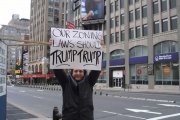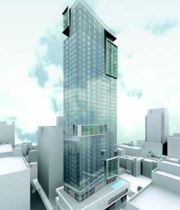SoHo Political Activity Through the Years
From The Peopling of NYC
DUMBO (Down Under the Manhattan Bridge Overpass) was once a popular place for hundreds of artists to settle in the empty factory buildings and dirty old Civil War offices. However, a new waterfront property being built on the East River has indirectly forced artists out and welcomes others in. One unknown landlord in SoHo said in 1995,
“I feel like they are animals and they ought to be put in cages. We’re trying to get rid of them. They are in our way.”
In response to that statement, Sara Pasti, a painter living in SoHo in 1995, said,
“We were under siege. They are not passive in their desire to have us disappear.”
This more recent social change is almost identical to what happened in SoHo only a few years earlier. All over Manhattan, artists look for apartments with a lot of space and extremely cheap rent. They settle into deserted areas where landlords jump at the chance to rent out their land to anyone who would take it. Together, they make themselves a community. Then, as soon as the neighborhood they built becomes more popular, it is legalized as a residential area and artists are quickly kicked out in response to an influx of art galleries, restaurants, bars, and boutiques. These places simply agree to pay higher rents. When SoHo Real Estate Market rises, the number of art lovers and wealthy people also rises, but the population of artists is severely compromised.
In the late 1960s, Robert Moses, the great urban NYC planner, proposed the building of a Lower Manhattan Expressway that would have reduced much of SoHo's handsome cast-iron district to rubble. Robert Moses had envisioned three spectacular expressways over Manhattan including the Lower Manhattan Expressway, also known as LoMEx, that would run across Broome Street and connect the Holland Tunnel with the Williamsburg and Manhattan bridges. By 1961, Moses had set in motion two immense federal initiatives, which would have leveled fourteen blocks along Broome Street in SoHo. The highway would have required thousands of historic structures to be condemned, and would have displaced nearly 10,000 residents and workers. David Rockefeller, who had a vast stake in Lower Manhattan, was one of the strongest supporters of this eight-lane elevated highway. Among its adversaries were community activist Jane Jacobs and the unofficial mayor of SoHo and Greenwich Village, Tony Dapolito. On December 11, 1962, there was a special executive session of the New York City Board of Estimate on the second floor of New York City Hall, where city officials voted unanimously to block the planned expressway. Without the efforts of these strong individuals protecting the beauty of this great neighborhood, SoHo would not be the neighborhood we know and love today.
SoHo was officially made into a historical district on August 17, 1973. As of that day, no structure was allowed to be externally rebuilt or torn down.
“The purpose of the designation is to retain the quality of the district. Certainly one of tese qualities is an almost uniform building height…This does not mean that no changes can ever be made. It simply means that the changes that we made must be appropriate to the design of the cast-iron buildings and to the surroundings,”
- Harmon H. Goldstone, Commission Chairman of SoHo (1973)
[edit] Use of cast-iron is known to have directly led to the development of the skyscrapers. Now, is the skyscraper destroying the home of its more humble prototypes?
Donald Trump, a billionaire, entrepeanuer, business executive, and television star, has recently decided to come to SoHo. He has just gotten approved to start construction on his new Trump SoHo New York Hotel Condominium.
This building, rising 45 stories on the corner of Spring Street and Varick Street, is designed to look like a beautiful silver glass tower. The five-star luxury condominium will have 407 various condominium constituents, some of them with full 360 degree views of New York City. The hotel will feature a huge spa and fitness center, a heated pool and private bathhouses, a hall, retail space, café and bar, a business center with conference rooms, a world-class restaurant, a private library, two floor lobby and lounge, white glove service, and full day room service and concierge service.
Furthermore, this hotel will be built in the very center of SoHo and owned by one of the winners of Trump’s show The Apprentice.
Unsurprisengly, opposition is at a peak to this new idea. According to residents, business owners, and historical preservationists, this development will completely break the area’s zoning code, which does not allow residencies to be built. Trump, on the other hand, claims that the tower is a hotel, making it a business and not a residence.
Others are afraid that the building will have a ripple effect, causing others to start building skyscrapers the like of Wall Street in a historical district where the tallest building is only twelve stories high. Even worse, this action will give other entrepreneurs the ability to build skyscraper residences in any industrial areas. Some people, like the SoHo Alliance, are against the huge height of the building and the traffic that the “condotel” will bring with it. Other opposers to the development just simply say that they don’t like Donald Trump, and do not trust him to not transform the area.
This time, Donald Trump may not get what he hoped for. On July 13th, a Community 2 subcommittee unanimously rejected the development bill.
RETURN TO SOHO HOME
(1)Image gotten from Photographer Unknown, http://www.thevillager.com/villager_201/donttrumpsoho.html, April 30, 2007.
(2)Unknown Photographer, www.curbed.com/archives/2006_05_tsoho.jpg, April 30, 2007.


